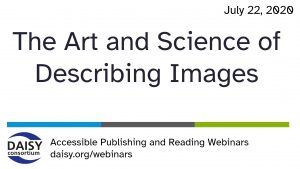The Art and Science of Describing Images (W)
 In our series of free weekly webinars July 22nd saw a session focused on the skill of writing image descriptions giving us an in-depth glimpse of how to approach various types of images.
In our series of free weekly webinars July 22nd saw a session focused on the skill of writing image descriptions giving us an in-depth glimpse of how to approach various types of images.
This page contains:
Full Video of the Webinar
Speakers
- Richard Orme, The DAISY Consortium—host and chair
- Valerie Morrison, Center for Inclusive Design at The Georgia Institute of Technology
- Huw Alexander, textBOX Digital
Session Overview
Valerie Morrison opened this session with reference to the 1st image description webinar that formed part of this series, held last month, which concentrated on best practice for publishers and explained that today’s session would look closer at editing tips for Alt Text and how to describe some of the more popular types of image.
The Art of Editing
Valerie had previously presented on her basic approach to image description and was useful to be able to go over these again in reference to today’s more detailed dive into the topic. Editing alt text is vital and being able to call on multiple people to perform a review is a good idea. Valerie gave our listeners 4 useful tips to help them craft effective descriptions:
Edit to Provide Clarity
Make sure you use specific language and simple word choices in order to be clear. Write out any acronyms and symbols and use proper grammar and punctuation
Edit to Organize Information
Work from the general to the specific and group like items together for ease of cognitive load. Organize information within your image description in predictable ways, listing similarities first.
Edit to Remain Neutral
Try not to instruct or go beyond what is contained within the image. You can describe actions or expressions but don’t attempt to interpret thoughts and feelings unless the context requires this.
Edit to Reduce Redundancy
Edit descriptions which are too wordy and cut unnecessary phrases. Avoid repeating a caption, if one is present, and try not to regurgitate the surrounding text.
Before moving on to some specific examples Valerie reminded us to consider the cognitive load of your reader. The average person can remember 7 items at a time so less is more where your image descriptions are concerned. Introducing fewer words helps the listener to process information more efficiently and by simplifying and reducing alt text length you care reducing auditory fatigue.
Describing the Most Popular Types of Image
Huw Alexander talked to us about a method that he and his team have devised to provide an organized approach to image description: the focus/LOCUS method which very much complements the approach that Valerie suggested, advocating working from the general to the specific along a pathway of scene-setting and story-telling.
Huw chose 7 image types for this particular webinar with the reassurance that other types will be looked at in future sessions in this series:
- Bar charts
- Pie charts
- Line charts
- Venn diagrams
- Flow charts
- Scatter plots
- Photographs
showing us the major areas of focus for each and then providing an in-depth example of how it should be done. This level of information is invaluable to those of us who are writing image descriptions on a daily basis and we look forward to the next session (October 7th) which will look at info-graphics and timelines and how to describe these, as well as complex content, test and examination materials and, not forgetting, tables!

